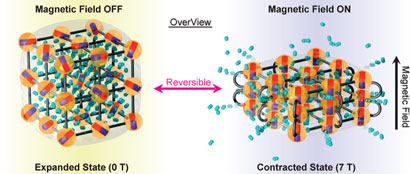Researchers in Japan and Singapore have created a sponge that can wring itself out upon application of a magnetic field. The sponge, which is based on a network of nanomagnets, could be used as a capsule that delivers drugs to specific parts of the human body.
First developed in the late 1990s, magnetic sponges consist of nanoparticles linked up by spring-like molecules. When the sponges absorb water they expand, and their overall magnetic properties change. As a result, they have been touted for use as sensors that can sensitively detect the presence of water.
Toshiaki Enoki of the Tokyo Institute of Technology and colleagues have now created a more active magnetic sponge. The sponge is fully expanded in its resting state, but on application of a magnetic field it contracts in the field's direction. According to co-author Yoshikazu Ito, this magnetic sponge could hold a drug until it reaches a desired area, at which point a magnetic field would carefully squeeze it out. 'Absorption and desorption can be controlled "when and where" with the magnet,' he says.

The magnetic sponge could be used as a highly controllable way to deliver drugs
© J. Am. Chem. Soc.
|
The sponge consists of groups of three nanometre-sized magnets, made of a cobalt-palladium alloy, linked together with springy alkyl-chain bridges. Unlike previous magnetic sponges, the nanoparticles in this sponge have a very large magnetic moment. In the absence of a magnetic field, these nanomagnets are randomly aligned, and so attractive van der Waals forces can absorb nitrogen into the structure. However, applying a magnetic field of 7 Tesla causes the nanomagnets to align like a ferromagnet, pulling themselves together while overcoming the van der Waals forces and expelling the nitrogen. The experiments were performed at around 2K.
Jaume Veciana Miró, an expert in magnetic sponges at the Autonomous University of Barcelona, Spain, calls the work a 'breakthrough result', and agrees it could be used for targeted drug delivery. 'The result of Enoki and coworkers is a step forward for real applications in the field of molecular magnetism, since to date only sponge-like sensors [have been] reported,' he says.
However, Jatinder Yakhmi of the Bhabha Atomic Research Center in Mumbai, India, who did some of the first research into magnetic sponges, points out that the low temperatures and high magnetic fields would preclude immediate applications.
Ito agrees: 'The [prototype] transformation is very poor for applications,' he says. 'Therefore, we need to arrange a magnetic sponge for high response at room temperature.'
Jon Cartwright
Interesting? Spread the word using the 'tools' menu on the left.




